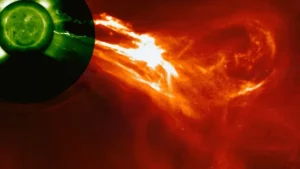GS 1-Geography

Context:
Scientists at the Indian Institute of Astrophysics (IIA) have detected a flareless coronal mass ejection (CME) using the Visible Emission Line Coronagraph (VELC) onboard Aditya-L1, India’s first dedicated solar observation mission.
Aditya-L1 Mission Overview:
Launch Date: September 2, 2023
Developed By: ISRO, with contributions from Indian research institutions
Mission Objective: Study the Sun’s corona, solar wind, and space weather impacts on Earth
Positioning: Located at Lagrange Point 1 (L1), approximately 1.5 million km from Earth
Key Features of Aditya-L1:
Continuous Solar Monitoring: Positioned at L1, providing an uninterrupted view of the Sun.
Advanced Scientific Instruments: Equipped with seven payloads for spectroscopy, coronagraphy, and space weather analysis.
Fuel Efficiency: The gravitational balance at L1 reduces fuel requirements for orbital corrections.
Early Warning System: Detects solar storms and radiation bursts before they impact Earth’s technology and infrastructure.
Understanding Flareless Coronal Mass Ejection:
What is a Flareless CME?
A flareless coronal mass ejection is a large-scale eruption of plasma and magnetic fields from the Sun’s corona, occurring without a preceding solar flare. Unlike typical CMEs, it does not emit strong X-ray or UV radiation before the eruption, making it harder to predict.
Formation Mechanism:
Magnetic Reconnection: Rearrangement of magnetic field lines in the Sun’s atmosphere releases energy.
Slow Magnetic Stress Build-Up: Plasma and magnetic energy accumulate gradually, eventually triggering an ejection.
Flux Rope Instability: A twisted magnetic structure in the corona loses stability, leading to a slow outward release.
No Preceding Flare: Unlike standard CMEs, there is no sudden burst of high-energy radiation before the ejection.
Sunspot Influence: Linked to weak or decaying magnetic fields, where flare energy is insufficient to trigger an explosive event.
Key Characteristics of Flareless CMEs:
Minimal Electromagnetic Signature: No significant X-ray or radio bursts, making them difficult to detect early.
Slower Ejection Speed: Moves at lower velocities (~400–1,000 km/s) compared to flare-associated CMEs.
Gradual Magnetic Disturbance: Initiated by a slow destabilization of coronal magnetic fields, rather than an impulsive event.
Impact on Space Weather: Can still cause geomagnetic storms, disrupting satellites, GPS, and communication networks on Earth.
Rare Occurrence: Less frequent than flare-driven CMEs, requiring advanced solar monitoring for better prediction.
Conclusion:
The discovery of a flareless CME by Aditya-L1 challenges existing models of solar eruptions and highlights the need for continuous space-based observation. Studying these events is crucial to understanding space weather phenomena and mitigating their impact on Earth’s technology and infrastructure.




